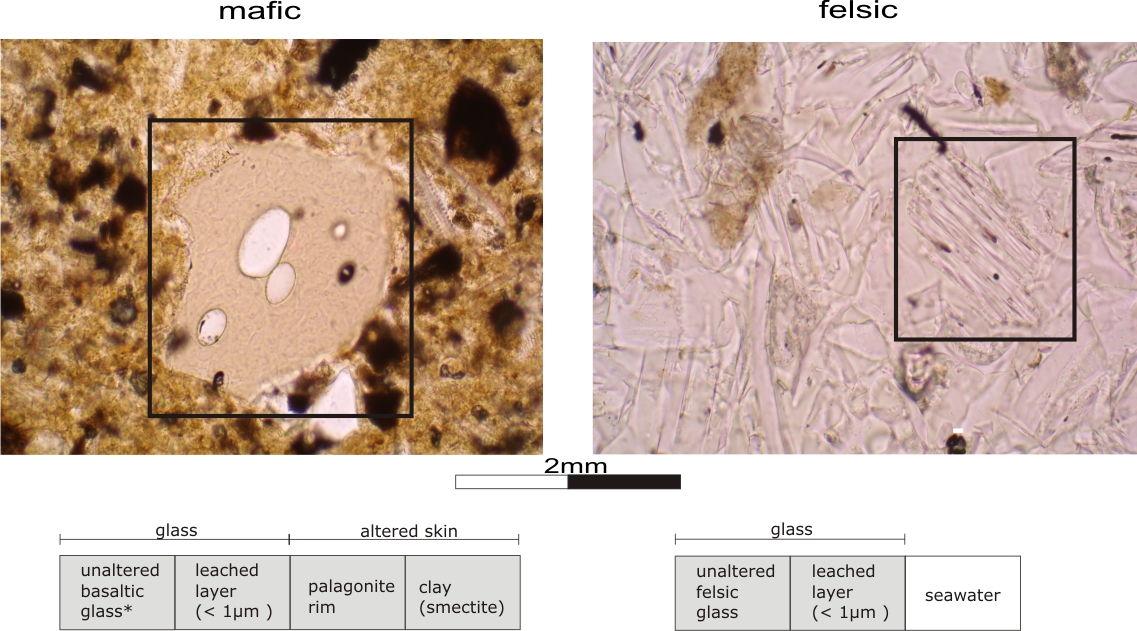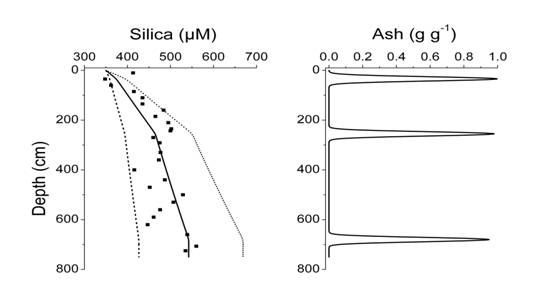 Web Content Display Web Content Display
Element recycling in forearc-sediments by volcanic glass alteration
Volcanic glass alteration is playing a major role in the global cycling of metals and nutrients. Because of the extensive volcanism that takes place along the volcanic front of Costa Rica and Nicaragua volcanic glass alteration at and beneath the seafloor can be considered as an important process driving element turnover. Moreover, altered volcanic glass is one of the major sediment fractions that is transported down the continental slope, injected into the subduction zone, and then imprinting again the volcanic arc signature.
The effects of volcanic ash alteration on the composition of pore fluids in marine surface sediments of the Costa Rica forearc area were studied in our subproject B5 by laboratory closed system experiments and field studies.
Main results of our studies on ash alteration are:
1. At low temperatures and elevated pressures felsic and mafic ash dissolution proceed at similar rates even though the dissolution and alteration mechanisms differ considerably. A general sketch of mafic and felsic ash alteration is shown in Figure 1.
Fig. 1: Microscopic images of a felsic (left) and a mafic (right) ash layer. Squares mark a pumice fragment and a glass shard. Alteration sketches for mafic and felsic ash particles are based of geochemical and were are of determined by
2. In our ash-bearing cores covering the upper 8 m of the sediment column, dissolved Ca and Mg decreased with sediment depth due to carbonate precipitation processes induced by the anaerobic degradation of organic matter, while dissolved K concentrations were affected by sampling artefacts. Hence, we could not resolve any significant effect of ash alteration on the major cation concentrations in pore fluids. This observation implies that ash alteration is a very slow process in marine surface sediments. Geochemical modelling of ash alteration in surface sediment (Fig. 2) clearly showed that the in-situ rate of ash dissolution is three orders of magnitude smaller than the rate predicted by laboratory studies for in-situ conditions (2 °C, pH=7.30, Al=0.05 μM, Si=350–550 μM). The deviation between field data and experimental results is probably related to the much shorter experimental observation time and the lower density of reactive surface sites in marine sediments.
Rate laws and kinetic constants derived from field data (porewater data) should therefore be considered in geochemical models of volcanic glass alteration at seafloor conditions.
Fig. 2: Dissolved silica concentrations and ash contents calculated for a sediment core of the Costa Rica forearc. Dissolved silica data are shown as solid squares. Solid lines indicate the best fit to the dissolved silica data and the ash concentration obtained with the pre-exponential Arrhenius factor AA=1.3×10−9 mol of Si cm−2 yr−1. Dotted and broken lines show the dissolved silica concentrations calculated with AA=3×10−9 mol of Si cm−2 yr−1 and AA=0.4×10−9 mol of Si cm−2 yr−1, respectively
3. Temperature-dependent laboratory alteration studies indicate that the decrease in dissolved Mg and the increase in Ca observed in fluids expelled at cold vent sites (Hensen et al., 2004) may be caused by volcanic ash alteration processes.
4. Considering the high REE release rates from marine ash layers measured in sediment cores of the Costa Rica forearc (i.e. max. 0.9 nmol Ce cm-2 yr-1), it is likely that the REE distribution in ocean waters and sediments is affected by large tephra outfalls due to REE release from reactive volcanic glasses. Rare earth elements (REE), particularly light REE, can be significantly mobilised in marine sediment during ash alteration processes.
Further reading
Hensen C, Wallmann K, Schmidt M, Ranero CR, Suess E (2004) Fluid expulsion related to mud extrusion off Costa Rica - a window to the subducting slab. Geology 32, 201-204.
Kutterolf S, Schacht U, Wehrmann H, Freundt A, Mörz T (2006) Onshore to offshore tephro-stratigraphy and marine ash layer diagenesis in Central America. In: G. Alvarado, J. Buntschuh (eds), Central America - Geology, Resources and Hazards. Balkema (Lisse, Netherlands, Tokio, Japan). Vol. 2, 395-423
Schacht, U. (2005) Alteration of volcanic glasses in marine sediments: laboratory experiments and field studies. PhD thesis, Univ. Kiel, Germany. link
Schacht U, Wallmann K, Kutterolf S, Schmidt M (2008) Volcanogenic sediment-seawater interactions and the geochemistry of pore waters. Chem. Geol. 249, 321-338.
|
 Events Events
Kieler Wissenschaftler fühlen den 'Puls der Erde' Wie funktioniert die Recyclingmaschine der Erde?Nach elf Jahren endet der Kieler Sonderforschungsbereich 574 zu Subduktionszonen Final colloquium of SFB 574 Teilprojekt ÖffentlichkeitsarbeitMEERESFORSCHUNG FÜR MICH UND DICH |
|
©SFB574 // Wischhofstrasse 1-3 // D-24148 Kiel // T. +49 (0)431 600 1413 // elange [AT] geomar.de







